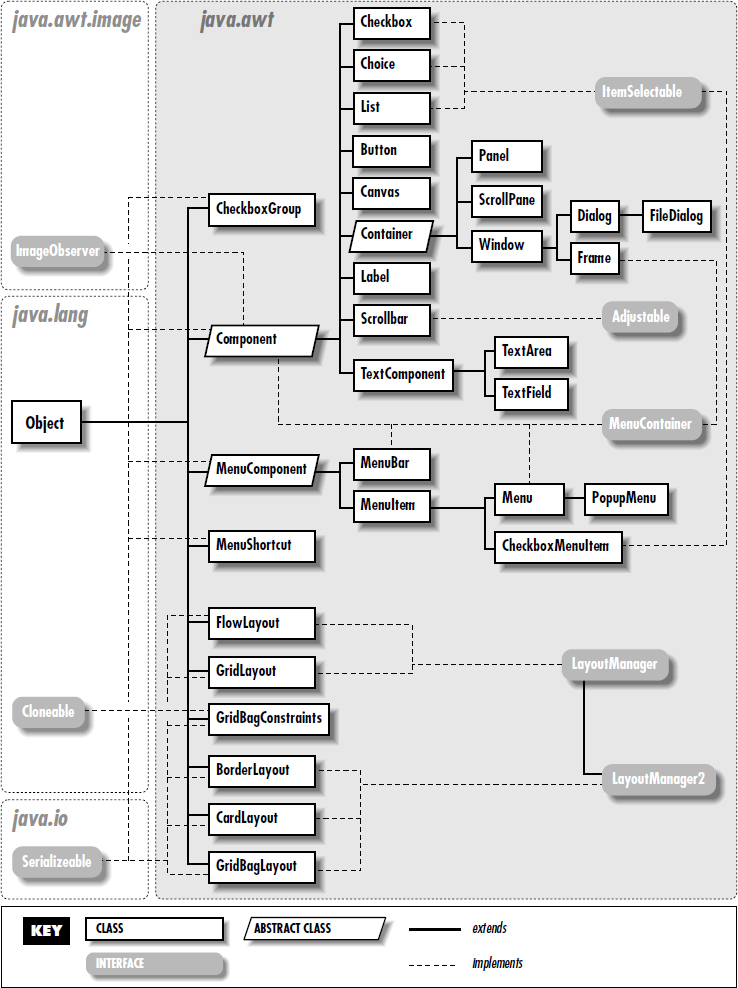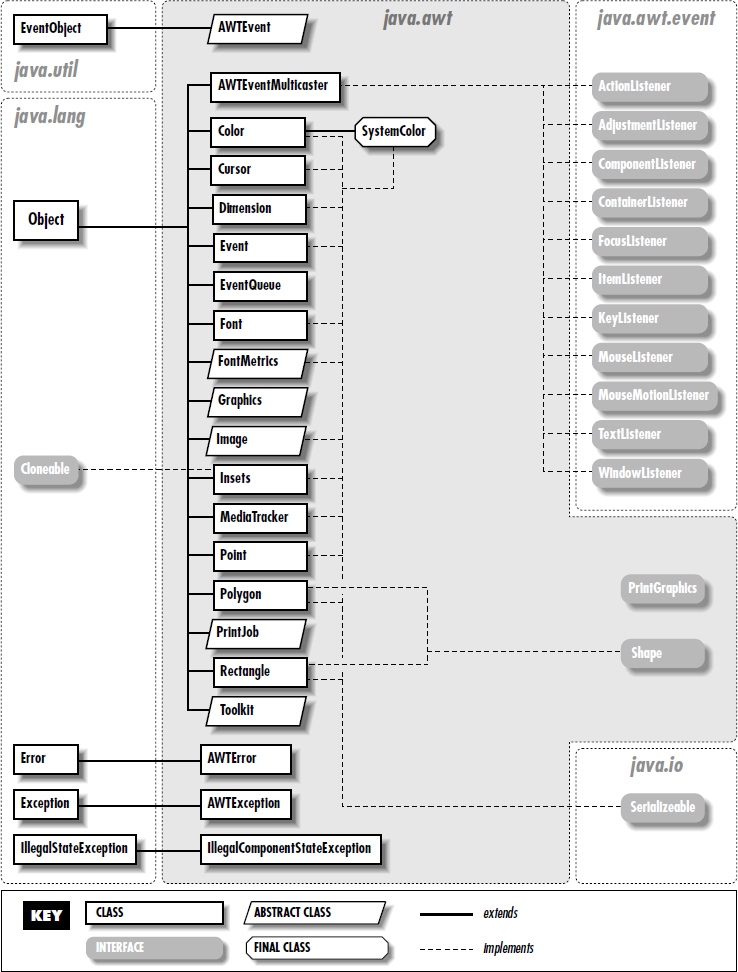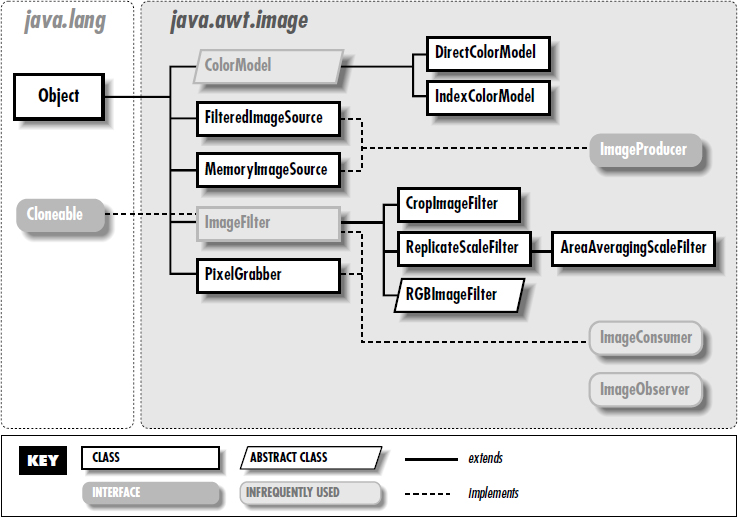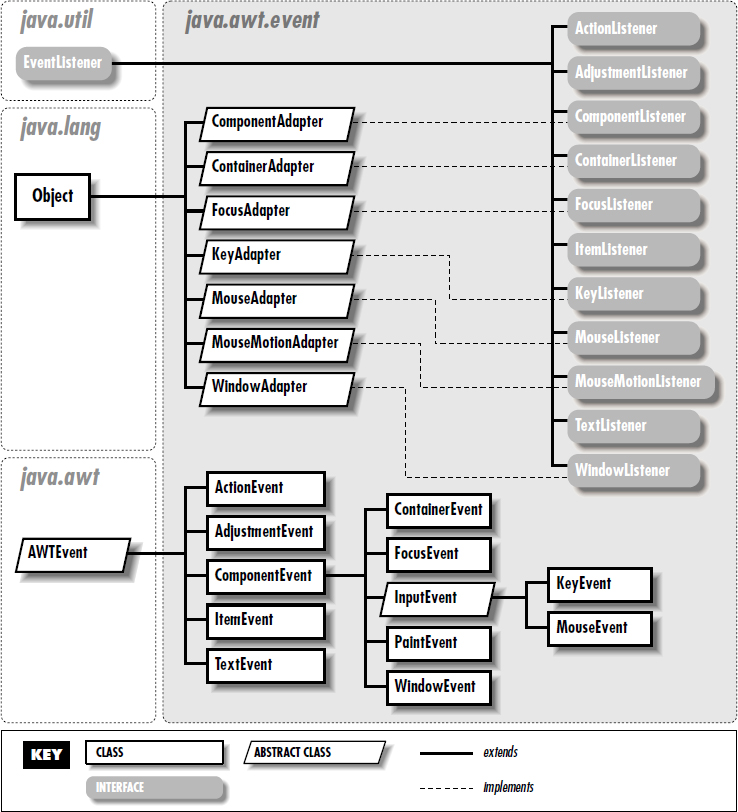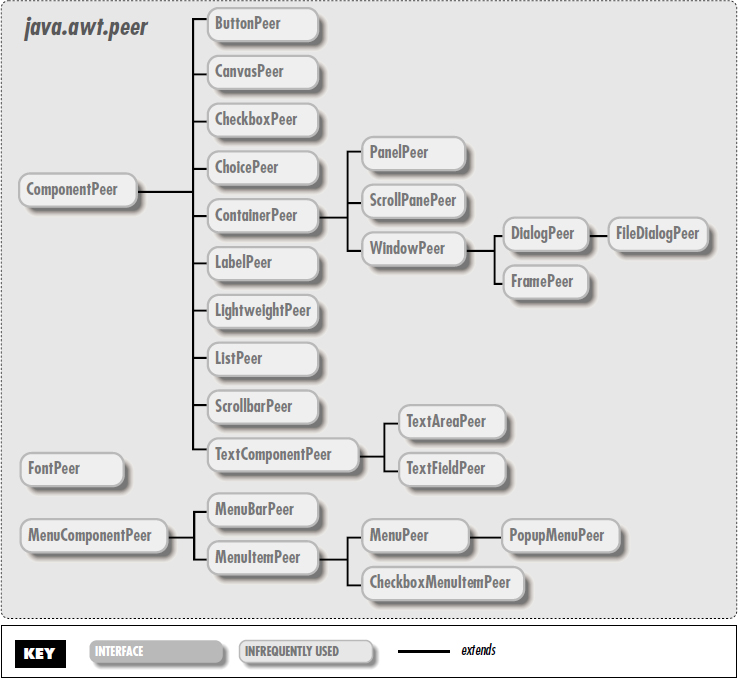18
java.applet Reference
In this chapter:
- Introduction to the Reference Chapters
- Package diagrams
Introduction to the Reference Chapters
The preceding seventeen chapters cover just about all there is to know about AWT. We have tried to organize them logically, and provide all the information that you would expect in a reference manual—plus much more in the way of examples and practical information about how to do things effectively. However, there are many times when you just need a reference book, pure and simple: one that's organized alphabetically, and where you can find any method if you know the class and package that it belongs to, without having to second guess the author's organizational approach. That's what the rest of this book provides. It's designed to help you if you need to look something up quickly, and find a brief but accurate summary of what it does. In these sections, the emphasis is on brief; if you want a longer description, look in the body of the book.
The reference sections describe the following packages:
- java.applet (Chapter 18, java.applet Reference)
- java.awt (Chapter 1, java.awt Reference)
- java.awt.datatransfer (Chapter 20, java.awt.datatransfer Reference)
- java.awt.event (Chapter 21, java.awt.event Reference)
- java.awt.image (Chapter 22, java.awt.image Reference)
- java.awt.peer (Chapter 23, java.awt.peer Reference)
Within each package, classes and interfaces are listed alphabetically. There is a description and a pseudo-code definition for each class or interface. Each variable and method is listed and described. New Java 1.1 classes are marked with a black star (![]() ), as are new methods and new variables. Of course, if a class is new, all its methods are new. We didn't mark individual methods in new classes. Methods that are deprecated in Java 1.1 are marked with a white star (
), as are new methods and new variables. Of course, if a class is new, all its methods are new. We didn't mark individual methods in new classes. Methods that are deprecated in Java 1.1 are marked with a white star (![]() ).
).
Inheritance presents a significant problem with documenting object-oriented libraries, because the bulk of a class's methods tend to be hiding in the superclasses. Even if you're very familiar with object-oriented software development, when you're trying to look up a method under the pressure of some deadline, it's easy to forget that you need to look at the superclasses in addition to the class you're interested in itself. Nowhere is this problem worse than in AWT, where some classes (in particular, components and containers) inherit well over 100 methods, and provide few methods of their own. For example, the Button class contains seven public methods, none of which happens to be setFont(). The font used to display a button's label is certainly settable—but to find it, you have to look in the superclass Component.
So far, we haven't found a way around this problem. The description of each class has an abbreviated class hierarchy diagram, showing superclasses (all the way back to Object), immediate subclasses, and the interfaces that the class implements. Ideally, it would be nice to have a list of all the inherited methods—and in other parts of Java, that's possible. For AWT, the lists would be longer than the rest of this book, much too long to be practical, or even genuinely useful. Someday, electronic documentation may be able to solve this problem, but we're not there yet.
Package diagrams
The following figures provide a visual representation of the relationships between the classes in the AWT packages.
java.awt, as the mother of all AWT packages, is better represented by two diagrams, one for the graphics classes and one for the component and layout classes.
Figure 18–1: Component and Layout classes of the java.awt package.
Figure 18–2: Graphics classes of java.awt package
Figure 18–3: The java.awt.image package
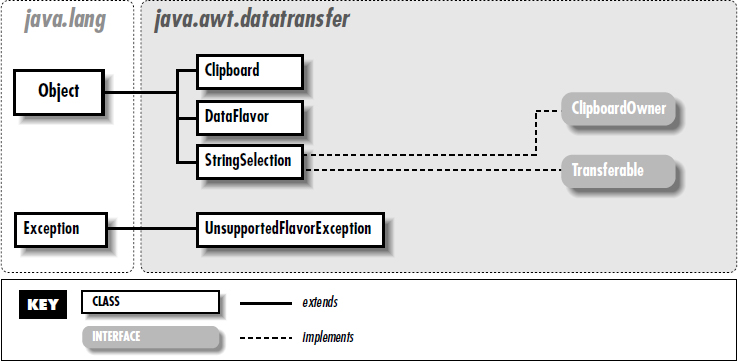
Figure 18–4: The java.awt.datatransfer package
Figure 18–5: The java.awt.event package
Figure 18–6: The java.awt.peer package
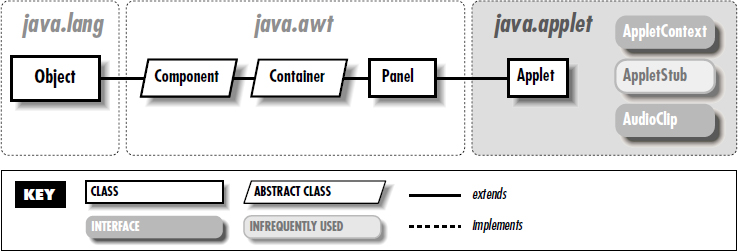
Figure 18–7: The java.applet package
18.1 Applet

Description
The Applet class provides the framework for delivering Java programs within web pages.
Class Definition
public class java.applet.Applet
extends java.awt.Panel {
// Constructors
public Applet();
// Instance Methods
public void destroy();
public AppletContext getAppletContext();
public String getAppletInfo();
public AudioClip getAudioClip (URL url);
public AudioClip getAudioClip (URL url, String filename);
public URL getCodeBase();
public URL getDocumentBase();
public Image getImage (URL url);
public Image getImage (URL url, String filename);
public Locale getLocale(); ![]() public String getParameter (String name);
public String[][] getParameterInfo();
public void init();
public boolean isActive();
public void play (URL url);
public void play (URL url, String filename);
public void resize (int width, int height);
public void resize (Dimension dim);
public final void setStub (AppletStub stub);
public void showStatus (String message);
public String getParameter (String name);
public String[][] getParameterInfo();
public void init();
public boolean isActive();
public void play (URL url);
public void play (URL url, String filename);
public void resize (int width, int height);
public void resize (Dimension dim);
public final void setStub (AppletStub stub);
public void showStatus (String message);
Constructors
Applet
public Applet()
| Description | Constructs an Applet object. |
Instance Methods
destroy
public void destroy()
| Description | Called when the browser determines that it doesn't need to keep the applet around anymore. |
getAppletContext
public AppletContext getAppletContext()
| Returns | The current AppletContext of the applet. |
getAppletInfo
public String getAppletInfo()
| Returns | A short information string about the applet to be shown to the user. |
getAudioClip
public AudioClip getAudioClip (URL url)
getCodeBase
public URL getCodeBase()
| Returns | The complete URL of the .class file that contains the applet. |
getDocumentBase
public URL getDocumentBase()
| Returns | The complete URL of the .html file that loaded the applet. |
getImage
public Image getImage (URL url)
| Parameters | url | URL of an image file. |
| Returns | Image to be displayed. | |
| Description | Initiates the image loading process for the file located at the specified location. | |
| public Image getImage (URL url, String filename) | ||
| Parameters | url | Base URL of an image file. |
| filename | Specific file, relative to url, that contains an image file. | |
| Returns | Image to be displayed. | |
| Description | Initiates the image loading process for the file located at the specified location. | |
getLocale
public Locale getLocale() ![]()
| Returns | Applet's locale. |
| Overrides | Component.getLocale() |
| Description | Used for internationalization support. |
getParameter
public String getParameter (String name)
| Parameters | name | Name of parameter to get. |
| Returns | The value associated with the given parameter in the HTML file, or null. | |
| Description | Allows you to get parameters from within the <APPLET> tag of the .html file that loaded the applet. | |
getParameterInfo
public String[][] getParameterInfo()
| Returns | Overridden to provide a series of three-string arrays that describes the parameters this applet reads. |
init
public void init()
| Description | Called by the system when the applet is first loaded. |
isActive
public boolean isActive()
| Returns | true if the applet is active, false otherwise. |
play
public void play (URL url)
| Parameters | url | URL of an audio file. |
| Description | Plays an audio file once. | |
| public void play (URL url, String filename) | ||
| Parameters | url | Base URL of an audio file. |
| filename | Specific file, relative to url, that contains an audio file. | |
| Description | Plays an audio file once. | |
resize
public void resize(int width, int height)
| Parameters | width | New width for the Applet. |
| height | New height for the Applet. | |
| Description | Changes the size of the applet. | |
| public void resize (Dimension dim) | ||
| Parameters | dim | New dimensions for the applet. |
| Description | Changes the size of the applet. | |
setStub
public final void setStub (AppletStub stub)
| Parameters | stub | Platform specific stubfor environment. |
| Description | Called by the system to setup AppletStub. | |
showStatus
public void showStatus (String message)
| Parameters | message | Message to display to user. |
| Description | Displays a message on the status line of the browser. | |
start
public void start()
| Description | Called by the system every time the applet is displayed. |
stop
public void stop()
| Description | Called by the system when it wants the applet to stop execution; typically, every time the user leaves the page that includes the applet. |
See Also
AppletContext, AppletStub, AudioClip, Container, Dimension, Image, Locale, Panel, String, URL
18.2 AppletContext

Description
AppletContext is an interface that provides the means to control the browser environment in which the applet is running.
Interface Definition
public abstract interface java.applet.AppletContext {
// Interface Methods
public abstract Applet getApplet (String name);
public abstract Enumeration getApplets(); public abstract AudioClip getAudioClip (URL url); public abstract Image getImage (URL url); public abstract void showDocument (URL url); public abstract void showDocument (URL url, String frame); public abstract void showStatus (String message); }
Interface Methods
getApplet
public abstract Applet getApplet (String name)
| Parameters | name | Name of applet to locate. |
| Returns | Applet fetched. | |
| Description | Gets a reference to another executing applet. | |
getApplets
public abstract Enumeration getApplets()
| Returns | List of applets executing. |
| Description | Gets references to all executing applets. |
getAudioClip
public abstract AudioClip getAudioClip (URL url)
| Parameters | url | Location of an audio file. |
| Returns | AudioClip fetched. | |
| Description | Loads an audio file. | |
getImage
public abstract Image getImage (URL url)
| Parameters | url | Location of an image file. |
| Returns | Image fetched. | |
| Description | Loads an image file. | |
showDocument
public abstract void showDocument (URL url)
showStatus
public abstract void showStatus (String message)
| Parameters | message | Message to display. |
| Description | Displays a message on the status line of the browser. | |
See Also
Applet, AudioClip, Enumeration, Image, Object, String, URL
18.3 AppletStub

Description
AppletStub is an interface that provides the means to get information from the run-time browser environment.
Interface Definition
public abstract interface java.applet.AppletStub {
// Interface Methods
public abstract void appletResize (int width, int height);
public abstract AppletContext getAppletContext();
public abstract URL getCodeBase();
public abstract URL getDocumentBase();
public abstract String getParameter (String name);
public abstract boolean isActive();
}
Interface Methods
appletResize
public abstract void appletResize (int width, int height)
| Parameters | width | Requested new width for applet. |
| height | Requested new height for applet. | |
| Description | Changes the size of the applet. | |
getAppletContext
public abstract AppletContext getAppletContext()
| Returns | Current AppletContext of the applet. |
getCodeBase
public abstract URL getCodeBase()
| Returns | Complete URL for the applet's .class file. |
getDocumentBase
public abstract URL getDocumentBase()
| Returns | Complete URL for the applet's .html file. |
getParameter
public abstract String getParameter (String name)
| Parameters | name | Name of a <PARAM> tag. |
| Returns | Value associated with the parameter. | |
| Description | Gets a parameter value from the <PARAM> tag(s) of the applet. | |
isActive
public abstract boolean isActive()
| Returns | true if the applet is active, false otherwise |
| Description | Returns current state of the applet. |
See Also
AppletContext, Object, String, URL
18.4 AudioClip

Description
AudioClip is an interface for playing audio files.
Interface Definition
public abstract interface java.applet.AudioClip {
// Interface Methods
public abstract void loop();
public abstract void play();
public abstract void stop();
}
Interface Methods
loop
public abstract void loop()
| Description | Plays an audio clip continuously. |
play
public abstract void play()
| Description | Plays an audio clip once from the beginning. |
stop
public abstract void stop()
| Description | Stops playing an audio clip. |
See Also
Object
Get Java AWT Reference now with the O’Reilly learning platform.
O’Reilly members experience books, live events, courses curated by job role, and more from O’Reilly and nearly 200 top publishers.
